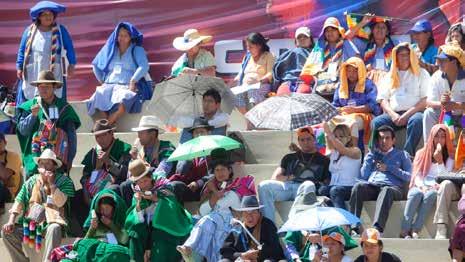
6 minute read
Martha Storey The future of polling
In politics, polling is inescapable. Barely a day goes by without someone predicting a Labour increase, a Liberal Democrat surge, or a Tory raise, prompting endless arguments about the significance of such figures at a time so far from the election. Polling permeates every part of politics, from party advertising to policy making, and it‘s role is only set to increase as data becomes more readily accessible.
When I think of polls, I think of the 2019 election, and the silence that filled the room when the exit poll appeared on our screens. Exit polls are surveys done at the ballot box of 144 constituencies, specially selected to broadly represent the country, but also to give a good indication of the Labour/Conservative swing. Academics then work through the day to project these results onto the remaining UK seats in order to produce a prediction for the total number of seats, and hence the result of the election.
Advertisement
Polling isn’t just important on election night - it increasingly shapes policy, strategy, and communications. Canvassing public opinion has always been part of successful politics, and as our methods of data analysis improve, parties can pinpoint the importance of specific policies to each demographic, as well as measure their current performance and adjust their behaviour accordingly. It’s not just in the run up to elections when this is important - looking closely, it becomes apparent that the Conservative’s approach to Covid restrictions stick close to the level of severity that the public think appropriate. Conveniently backed by public opinion [1], their current strategy contrasts sharply with last October’s messaging (even though the UK was experiencing similar numbers of cases). Parties can, and do, survey public opinion to ensure that the steps they take lead them in the right direction with regards to their popularity - a not-so-subtle reminder that, despite the lofty idealism of many people, myself probably included, politics is also about winning elections.
As the world’s reliance on data and technology increases, it would be expected that polls would get more and more accurate as time goes on. But, recent experience shows this isn’t the case. Polling has been off the mark as recently as 2015, where the Tories outperformed pollsters’ expectations, while Labour’s popularity was underestimated in 2017. Polling is adapting to new surveying methods, particularly ones using the internet, which naturally leads to error as pollsters try to find the most accurate surveying methods. As well as testing different online polling methods, more reliable methods like telephone polling have decreased in their success, going from a 36% response rate in America in 1997 to 6% today [2]. This naturally leads to fluctuations in accuracy, but the turbulence of current politics no doubt
Martha Storey, Maths and Philosophy at University College The future of polling
"If Labour is to have a chance in 2024, we must watch and reflect upon the importance of opinion polling."
While internet polling is easy and cheap, there are worries that it is unrepresentative of the general population. Not everyone regularly uses the internet [3] and, unlike the phone and address book records that parties can access, there is no database of all UK emails to sample from. There are ways around this - for example a mailed invitation to fill out an online survey - but they are laborious, and can still miss out those who, by nature of their relationship with technology, simply won’t fill out an online survey.
Other methods that don’t take a random sample include polls advertised on social media, websites, or through specific loyalty programmes. While cheaper to execute, methods like these are naturally self-selecting, with people from certain demographics much more likely to fill them out. The relatively recent development of new methods of polling means that, despite improvements in data analysis, polls aren’t necessarily more accurate, which explains the recent discrepancy between polls and election results.
It’s important that we are careful with how we treat polls. As well as the risk of policies being overly dictated by polls, clumsy reporting of polls can - and does - impact the outcome of elections, especially when voter projections are translated into probabilities of a given candidate winning an election. Small differences in voter projections can result in large differences in the probability of a given party winning. Studies show that, based on the same underlying data, voters who are told the probability of a candidate winning, as opposed to the projected vote share, are much more confident that a given candidate will win, despite their predictions being largely inaccurate [4].
Certainty about who will win an election makes it less likely that people will vote. If candidates look like they are on equal footing, people are more likely to go to the effort of voting. Consequently, the way that journalists report the results of polling can seriously impact the outcome of a given election.
Polling isn’t the only option for predicting election outcomes - models from physics have proven accurate in predicting election results. In ‘sociophysics’ [5], voters are modelled as particles, with spin in certain directions correlating to a voter's inclination to vote for different parties. The direction which a given particle spins (and hence which party a voter is likely to vote for) affects the particles around it, making them more likely to spin in the same direction. However other things, like the heat and energy, make this less likely. Rather than modelling all voters on identical homogeneous particles, this method of predicting outcomes uses each particle’s slightly varying magnetic fields to model each individual voter’s differing opinions and influences.
The key advantage of modelling in this way is that it can account for “phase transitions”, when a physical system shifts from one way of organising itself to another. This is great for modelling changes in
public opinion, and suggests there is a “tipping point” beyond which the number of people holding extreme views increases at a higher rate. While this method doesn’t tell us anything about the reasons why people vote how they do, it is extremely accurate in predicting how they will vote, giving close results in the French Presidential election in 2017, and the 2018 US mid-terms.
Polling carries great political heft, but must quickly adapt to the digital age in order to be useful to politics. Fields like sociophysics demonstrate that advances are being made beyond conventional polling methods. However, their scope is limited to merely predicting the outcome of an election, rather than producing data that parties can use to inform policy. It is clear that the Conservatives are already keenly aware of polling data and the information it represents - if Labour is to have a chance in 2024, we must watch and reflect upon the importance of opinion polling.
Sources
[1] Gye, Hugo. 2021. inews: Lockdown roadmap: Reopen schools on 8 March – but pubs and restaurants should wait, i poll reveals. Online: https://inews.co.uk/news/politics/poll-reopen-schools-8-march-wait-april-ease-lockdown-878689 [retrieved 26/03/2021] [2] Deane, Claudia; Kennedy, Courtney; Keeter, Scott. 2019. Pew Research Centre Models: A Field Guide to Polling: Election 2020 Edition. Online: https://www.pewresearch.org/methods/2019/11/19/a-field-guide-to-polling-election-2020-edition/ [retrieved 26/03/2021] [3] Anderson, Monica; Perrin, Andrew; Jiang, Jingjing; Kumar, Madhumitha. 2019. Pew Research Centre: 10% of Americans don’t use the internet. Who are they? Online: https://www.pewresearch. org/fact-tank/2019/04/22/some-americans-dont-use-the-internet-who-are-they/ [retrieved 26/03/2021] [4] Messing, Solomon. 2018. Pew Research Centre: Use of election forecasts in campaign coverage can confuse voters and may lower turnout. Online: https://www.pewresearch.org/fact-tank/2018/02/06/use-of-election-forecasts-in-campaign-coverage-can-confuse-voters-and-may-lower-turnout/ [retrieved 26/03/2021] [5] Brazil, Rachel. 2020. Physics World: The physics of public opinion. Online: https://physicsworld.com/a/the-physics-of-public-opinion/ [retrieved 26/03/2021]










